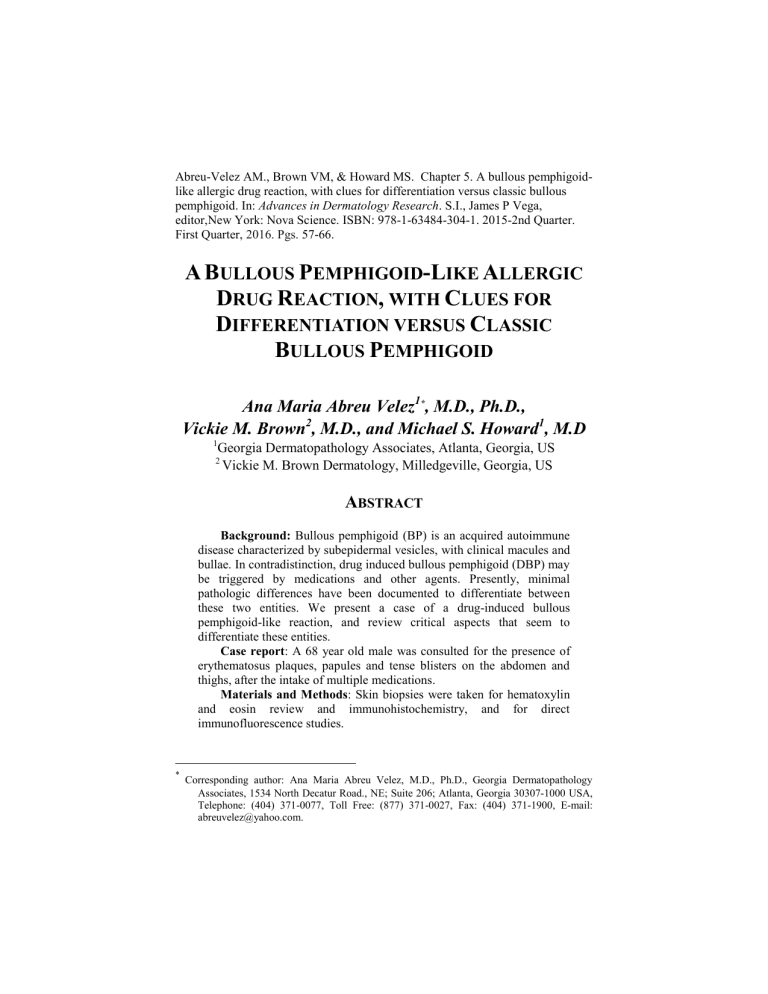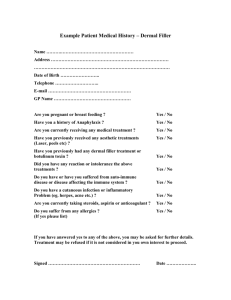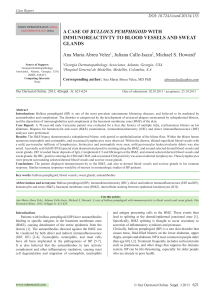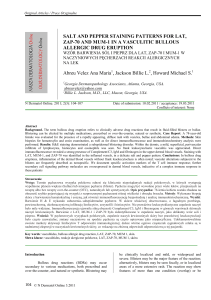Clues to differentiate BP versus BP by drugs
advertisement

Abreu-Velez AM., Brown VM, & Howard MS. Chapter 5. A bullous pemphigoidlike allergic drug reaction, with clues for differentiation versus classic bullous pemphigoid. In: Advances in Dermatology Research. S.I., James P Vega, editor,New York: Nova Science. ISBN: 978-1-63484-304-1. 2015-2nd Quarter. First Quarter, 2016. Pgs. 57-66. A BULLOUS PEMPHIGOID-LIKE ALLERGIC DRUG REACTION, WITH CLUES FOR DIFFERENTIATION VERSUS CLASSIC BULLOUS PEMPHIGOID Ana Maria Abreu Velez1*, M.D., Ph.D., Vickie M. Brown2, M.D., and Michael S. Howard1, M.D 1 Georgia Dermatopathology Associates, Atlanta, Georgia, US Vickie M. Brown Dermatology, Milledgeville, Georgia, US 2 ABSTRACT Background: Bullous pemphigoid (BP) is an acquired autoimmune disease characterized by subepidermal vesicles, with clinical macules and bullae. In contradistinction, drug induced bullous pemphigoid (DBP) may be triggered by medications and other agents. Presently, minimal pathologic differences have been documented to differentiate between these two entities. We present a case of a drug-induced bullous pemphigoid-like reaction, and review critical aspects that seem to differentiate these entities. Case report: A 68 year old male was consulted for the presence of erythematosus plaques, papules and tense blisters on the abdomen and thighs, after the intake of multiple medications. Materials and Methods: Skin biopsies were taken for hematoxylin and eosin review and immunohistochemistry, and for direct immunofluorescence studies. * Corresponding author: Ana Maria Abreu Velez, M.D., Ph.D., Georgia Dermatopathology Associates, 1534 North Decatur Road., NE; Suite 206; Atlanta, Georgia 30307-1000 USA, Telephone: (404) 371-0077, Toll Free: (877) 371-0027, Fax: (404) 371-1900, E-mail: abreuvelez@yahoo.com. 2 Ana Maria Abreu Velez, Michael S. Howard and Vickie M. Brown Results: The H&E histology showed small subepidermal blisters with minimal fibrin and some eosinophils within the blister lumens; no epidermal vacuolar degeneration or acantholysis were noted. Not significant edema was noted in the epidermis or dermis. Direct immunofluorescence revealed dotted complement/C3c and linear, discontinuous IgG deposits along the basement membrane zone(BMZ). In addition, cells strongly positive for CD20 and BCL2 were noted within the lesional inflammation. Conclusion: Some histologic clues favoring a bullous pemphigoidlike allergic drug reaction may include absence of epidermal vacuolar degeneration, edema, fibrin deposits, blister festoons and a significant luminal eosinophilic infiltrate. In addition to these findings, CD20 cells are normally not found in most cases of classic BP; in classical BP, HLADP, DQ, DR antigen is often strongly expressed in the lesions, which was not the case here. In addition, in contrast to classic BP, we noted discontinuous staining at the BMZ with immunoglobulins and complement. Keywords: Bullous pemphigoid, drug induced bullous pemphigoid, BCL-2 ABBREVIATIONS AND ACRONYMS BP DBP IHC DIF, IIF H&E BMZ BCL2 TIMP-1 LAT Bullous pemphigoid Drug induced bullous pemphigoid immunohistochemistry direct and indirect immunofluorescence hematoxylin and eosin basement membrane zone B-cell lymphoma 2 gene tissue inhibitor of metalloproteinases 1 linker for activation of T cells CASE REPORT: A 68 year old Caucasian male presented with a sudden appearance of erythematous papules, plaques and few blisters on the abdomen, back, arms, and thighs; focal excoriations were also noted. Some of the lesions were violaceous. The patient was taking Lisinopril angiotensin converting enzyme(ACE inhibitor), Glyburide (micronase), Metformin, over the counter cinnamon, Aleve, ProAir® HFA (albuterol sulfate), Symbicort® (budesonide/formoterol fumarate dihydrate), Cartia XT (Diltiazem A Bullous Pemphigoid-Like Allergic Drug Reaction … 3 Hydrochloride Extended Release), Aciphex (rabeprazole sodium), Spiriva®, HandiHaler® (tiotropium bromide inhalation powder), Tacrolimus cream and ciprofloxacin. The patient presented a clinical history of chronic obstructive pulmonary disease (COPD), hay fever and allergies, diabetes and arthritis. A skin biopsy for hematoxylin and eosin stain (H&E) and immunohistochemistry (IHC) was taken, as well as a biopsy for direct immunofluorescence(DIF) studies. INTRODUCTION Autoimmune bullous pemphigoid (BP) is a skin disease for which the etiology is idiopathic and unknown, with the highest occurrence in elderly patients [1]. However, similar disease lesions may occur with the formation of subepidermal blisters in the setting of an allergic drug reaction [2-7]. Minimal data is available regarding subtle pathologic differences between BP and drug induced BP. Drug-induced BP variants are often characterized by linear IgG and C3 along the basement membrane zone (BMZ) on direct immunofluorescence (DIF); on indirect immunofluorescence, the antibodies bind to the epidermal side (roof) of salt split skin. In addition, Western immunoblotting has demonstrated that DBP antibodies react with both the 230 kD and 180 kD bullous pemphigoid (BP) antigens [2-7]. Histologically, is also accepted that drug-induced BP often seems to be similar to typical BP, demonstrating an eosinophil-rich subepidermal blister. We report a case of drug induced BP with several subtle differences from classic autoimmune BP that have not been previously described. MATERIALS AND METHODS Hematoxylin and eosin (H&E) staining, immunohistochemistry (IHC) and direct immunoflurorescence (DIF) studies were performed as previously described [8-14]. Immunohistochemistry: We utilized the following antibodies: monoclonal mouse anti-human linker for activation of T cells (LAT) protein, HLA-ABC, HLA-DP, DQ, DR antigen, BCL2, CD4, CD8, CD20, CD45, complement/C5b-9/MAC, monoclonal mouse anti-human B-cell lymphoma 2 (BCL2) oncoprotein clone 124, CD20y, complement/C3c and C3d, CD99, tissue inhibitor of metalloproteinases 1(TIMP-1), monoclonal mouse anti- 4 Ana Maria Abreu Velez, Michael S. Howard and Vickie M. Brown human myeloid/histiocyte antigen (Clone MAC 387), metallothionein, polyclonal rabbit anti-human myeloperoxidase (all from Dako, Carpinteria, California, USA), and HAM-56 from Cell Marque. Direct Immunofluorescence (DIF): For DIF, we incubated 4 micron glass slides with our secondary antibodies as previously described [8-14]. We utilized FITC conjugated rabbit anti-total IgG (Dako, Carpinteria, California, USA) at a 1:25 dilution. The samples were run with positive and negative controls. We also utilized FITC conjugated rabbit antisera to human IgG, IgA, IgM, complement/C1q, complement/C3, fibrinogen and albumin. Antihuman IgA antiserum (alpha chain) and anti-human IgM antiserum (mu chain) were obtained from Dako. Anti-human IgE antiserum (epsilon chain) was obtained from Vector Laboratories (Burlingame, California, USA). Anti-human IgD FITC-conjugated antibodies were obtained from Southern Biotechnology (Birmingham, Alabama, USA). The slides were counterstained with 4’,6-diamidino-2phenylindole (DAPI) (Pierce, Rockford, Illinois, USA). A mouse anti-collagen IV monoclonal antibody (Invitrogen, Carlsbad, California, USA) was also utilized, with secondary donkey antimouse IgG antisera (heavy and light chains) conjugated with Alexa Fluor 555 (Invitrogen). RESULTS Microscopic Description: Examination of the H&E tissue sections demonstrates an early subepidermal blistering disorder. Within the blister lumen, several eosinophils were present, with occasional lymphocytes. Neutrophils were rare. Dermal papillary festoons were not observed. Within the dermis, a mild, superficial, perivascular infiltrate of lymphocytes, histiocytes and eosinophils is identified. No significant edema or fibrin were seen in the lesions (see Figure 1). A Bullous Pemphigoid-Like Allergic Drug Reaction … 5 Figure 1. a. H&E staining shows a subepidermal blister (black arrow) with upper dermal perivascular infiltrate featuring lymphohistiocytic cells and few eosinophils and rare neutrophils (100X). b. H&E staining at 400X shows eosinophilic round bodies, present in the blister areas (red arrows). In c, IHC staining with anti-human Complement/C3d, showing positivity to the bodies in b. The same reactivity is seen around upper dermal blood vessels, suggesting that these structures may be the source of Complement in the blister (black arrows). d. DIF, featuring FITC conjugated IgG in a pseudo-linear BMZ pattern, in contrast to that regularly seen in autoimmune bullous pemphigoid (yellow staining; white arrow). e. DIF with FITC conjugated anti-human Complement/C3c “dotted staining” along the BMZ (green staining; white arrow). f. IHC stain showing C5b-9/MAC positive around skin appendix supply blood vessels (brown staining; black arrows). g. Double IHC staining, utilizing CD45 in brown and HLA-DP, DQ, DR antigen in red is seen around dermal blood vessels (black arrow), as well around vessels near a sebaceous gland(lower red arrow). Please note that the BMZ of the sebaceous glands stains positive for HLA-DP, DQ, DR antigen. h. Identical markers and colors as in g, with higher magnification showing the positive blood 6 Ana Maria Abreu Velez, Michael S. Howard and Vickie M. Brown vessel staining for HLA-DP, DQ, DR antigen (red staining; black arrows) and the cells around them positive for CD45(brown staining; black arrows) (200X). i. IHC, showing positive staining with myeloperoxidase around a sebaceous gland, and also inside a hair follicle (brown staining; black arrow). Direct Immunofluorescence(DIF): We observed the following results: IgG (+; focally linear at BMZ; focal positivity around superficial and deep dermal blood vessels); IgA(-); IgM(-); IgD (-); IgE (-); complement/C3 (+; focal, microgranular deposits in dots at the basement membrane zone of the skin, (BMZ); focal positivity around dermal blood vessels); Kappa light chains (+; focal positivity around upper dermal blood vessels and on dermal eccrine glands); Lambda light chains (+; focal linear BMZ and focal positivity around dermal blood vessels); albumin (+; focal linear at the BMZ; focal positivity around superficial and deep dermal blood vessels) and fibrinogen (+; focal linear BMZ; focally around superficial and deep dermal blood vessels) (see Figures 1 and 2). A Bullous Pemphigoid-Like Allergic Drug Reaction … 7 Immunohistochemistry: HLA-ABC was positive in the epidermis, as well as in the upper vessels and dermal infiltrate. C-5b-9/MAC was positive in some patches at the BMZ, in several dermal vessels, between dermal collagen fibers and around the sweat glands. CD20y, CD4, CD8, BCL2 and LAT were positive around the upper dermal blood vessels in the infiltrate. CD45 was also positive around those vessels, and also within the infiltrate around focal hair follicles. Figure 2. The dermal blood vessels exhibit significant involvement in this disease. a. Double staining IHC, showing positive cells with CD4 in brown and CD8 in red colocalizing around upper dermal blood vessels(especially near hair follicles) (red arrows). b. IHC, demonstrating positive staining with BCL-2 at the base of a hair follicle (brown staining; red arrow). c. Double IHC staining, showing positive CD45 in brown and positive HLA-DP, DQ, DR antigen in red around the BMZs of a sebaceous gland (red arrow), as well as around deep dermal neurovascular complexes (black arrow). d. DIF, showing positivity using FITC conjugated anti-human fibrinogen around upper and intermediate depth dermal blood vessels (green-white staining; red 8 Ana Maria Abreu Velez, Michael S. Howard and Vickie M. Brown arrows). The nuclei of nearby cells were counterstained with Dapi (light blue). e. DIF, showing positivity for FITC conjugated anti-human lambda light chains around dermal blood vessels (green staining; white arrow). f. DIF, showing positive staining for FITC conjugated anti-human IgE to upper and intermediate dermal blood vessels (green staining; white arrows) as well as some uneven staining in dermal papillary areas of the BMZ (red arrows) g. IHC staining, using anti-human HAM-56 and positive around dermal blood vessels (brown staining; red arrow). h. IHC staining, positive for LAT around upper dermal blood vessels (brown staining; red arrow). i. IHC with LAT positive staining around dermal blood vessels (brown staining; red arrow); thus, T lymphocyte activation is occurring near the vessels. Figure 3. a, b and c. IHC positive staining with BCL-2. In a, against inflammatory cells around a hair follicle (100X). In b, against an inflammatory infiltrate around upper dermal blood vessels as well as along the BMZ (brown staining; red arrows). c. At the base of a hair follicle (brown staining; red arrow). d. Double staining with IHC, showing positive cells with CD45 in brown and HLA-DP, DQ, DR antigen in red in the area of the blister. Please note that the CD45 positive cells are present in an area A Bullous Pemphigoid-Like Allergic Drug Reaction … 9 where the HLA-DP, DQ, DR antigen expression is diminished(black arrow). e. IHC staining with CD68, positive in the blister area (brown staining; black arrow). f. Positive staining with HAM-56 in the blister and under the blister (brown staining, black arrow). g. Double staining with IHC, showing positive cells for CD4 in brown and for CD8 in red, colocalizing around dermal blood vessels (red arrow) and at the BMZ (black arrow). h. IHC staining for TIMP-1 shows positive staining in the epidermis and inside the blister (brown staining; black arrow), as well as in several areas in the dermis that seem to be some type of cell junction between small blood vessels and dermal stromal cells (brown staining; red arrow). i. IHC staining for metallothionein, positive within the epidermis (brown staining; black arrow) and also around dermal blood vessels and on selected dermal cells(brown staining; red arrow). BCL2 was also positive at the base of some hair follicles, along with CD20y. HAM-56 and myeloid/histiocyte antigen were positive in the blister, and in the vessels under the blister. TIMP-1 was positive in the epidermis, and around dermal blood vessels in the inflamatory infiltrate. Metallothionein was positive along the epidermal BMZ, around dermal blood vessels and on selected other dermal cells. No strong expression of HLA-DP, DQ, DR antigen was noted in the blisters; a fibrin was noted in the blisters. No linear, welldefined IgG or Complement/C3 was noted along the BMZ. No vacuolar degeneration was noted along the BMZ. Only a few infiltrate cells around upper dermal blood vessels were positive for CD15(See Figures 1 through 3). Of further interest, myeloperoxidase positive cells amalgamated with HLADR, DP, DQ antigen and CD45 positive cells along the BMZ, forming rounded bodies (Figures 1 a through c). DISCUSSION A diversity of drugs have been associated with the induction of DBP including captopril, ciprofloxacin, penicillamine, penicillins, phenacetin, sulfasalazine, galantamine hydrobromide, levetiracetam, enoxaparin, spironolactone chloroquine, furosemide, ibuprofen, phenacetin, mefenamic acid, nifedipine and others [1-5]. However, most authors do not place much emphasis on pathologic differentiation between classical BP and DBP. The medical literature reports that clinical BPD is very similar to idiopathic or classic clinical BP disease, although the clinical lesions seem to often be polymorphic in BPD [2-5]. The clinical lesions of BPD seem to resemble drug-induced bullous dermatoses, erythema multiforme, eczematous dermatitis or porphyria cutanea tarda [2-5]. The literature states that in DPB, the mucous membranes are often involved; however, in our case no mucosal lesions were noticed. In Table 1, we noted the main differences we were able to find in this 10 Ana Maria Abreu Velez, Michael S. Howard and Vickie M. Brown DBP case, versus our classic BP cases. In DBP, epidermal and dermal edema were lacking; further, the acantholysis, vacuolar degeneration, and fibrin in the blister were not seen as in classic BP. In our case DIF, we also noticed that our findings seemed to be a slightly different that in classic BP. For examples, in our DBP case, C3C was dotted and non-linear along the BMZ, in contrast to classic BP. Our DBP IgG was also not completely linear and continuous along the BMZ. Our DBP fibrinogen was negative at the BMZ, versus classic BP in which a linear BMZ pattern may be found. For more details, please see Table 1. Table 1. Comparison and contrast between classic BP and our DBP case, including histopathologic findings and IHC and DIF staining Disease feature Overall H&E Eosinophils Neutrophils BP DBP The subepidermal blister contains substantial fibrin, eosinophils and afew dendritic cells within its lumen. Epidermal spongiosis and acantholysis, and vacuolar degeneration of the BMZ are noted. Intraepidermal eosinophilic abscesses may be seen. Dermal edema is noted in the area around the blisters. Some inflammatory cells are noted among dermal cell junctions. Strong infiltrate around the upper dermal blood vessels, and inside subepidermal blisters. The blister contains little or no fibrin or dendritic cells. Minimal spongiosis, lack of intraepidermal eosinophilic abscesses, and lack of both acantholysis and vacuolar degeneration of the BMZ. Minimal dermal edema around the blisters. Lack of inflammatory cells among dermal cell junctions. No dermal festoons. Lymphohistioc ytic infiltrate Usually present with the eosinophils within dermal papillae. Sometimes small numbers are present within the subepidermal blisters. Primarily around the upper dermal blood vessels. Myeloperoxid Positive around the upper dermal A few cells within the subepidermal blister lumen, along with perivascular and interstitial infiltrates. Often present in significant numbers, especially under the BMZ as well as around upper dermal blood vessels. Around upper and intermediate dermal blood vessels, as well as around skin adnexal structures(including hair follicles and eccrine glands). Significantly positive around A Bullous Pemphigoid-Like Allergic Drug Reaction … ase(IHC) blood vessels. CD15 (IHC) Significantly positive under the BMZ, and around upper dermal blood vessels. Minimally seen around upper dermal blood vessels, and/or close to the blisters. CD4 (IHC) Disease feature CD8 (IHC) CD20(IHC) Commonly seen around upper dermal blood vessels, and/or the blisters. Negative. Commonly seen around upper dermal blood vessels, and/or the blisters. Positive around the upper dermal blood vessels Commonly seen around upper dermal blood vessels, and/or the blisters. Dotted BMZ and/or irregular linear, not complete linear pattern. Linear pattern at the BMZ. IgG (DIF) Linear at the BMZ, as well as on dermal eccrine glands. Fibrinogen (DIF) IgM (DIF) Negative. IgE (DIF) Commonly seen around upper dermal blood vessels, and/or close to the blisters. DBP Commonly seen around upper dermal blood vessels. IgD (DIF) upper dermal blood vessels and under the BMZ, and/or present within the blister. Minimally positive. BP CD45 (IHC) Linear BMZ pattern, as well as on eccrine glands. Similar to patterns of the other immunoglobulins and complement components. Tendency to be linear positive at the BMZ, as well as present around upper dermal blood vessels. Complement/ C3c (DIF). Linear pattern at the BMZ, as well as on eccrine glands. Complement/ C3d (DIF) Positive in some upper dermal blood vessels, subjacent to the blisters. 11 Basically negative. Negative. Scattered cells positive in the dermis; spot positivity in the papillary dermis, and around some upper and intermediate dermal blood vessels. Dotted and/or irregular pattern at the BMZ, not completely linear. Positive around the upper dermal blood vessels. In our case, we initially suspected BP; however, following a review of the immune response we rendered a diagnosis of DBP. Many alleged drug 12 Ana Maria Abreu Velez, Michael S. Howard and Vickie M. Brown reactions are single case reports, particularly with patients taking multiple medications. It is often thus difficult to determine which associations are coincidental, and which are genuine. In occasional reports, recrudescence following re-exposure to the offending agent has been documented. The precise mechanism of drug-induced blistering is unknown, although multiple factors have been suggested, including direct toxicity to BMZ constituents or intercellular junctions with resultant autoantibody production. Thus, the offending drug may function as a hapten, or have similar antigenicity to BMZ components. In our case, serum was not available for study and we could not perform indirect immunofluoresence. Some histologic features of DBP that have been documented include linear IgG and C3 along the BMZ on DIF. On indirect immunofluorescence, the pertinent antibodies bind to the epidermal side (roof) of salt split skin. In addition, Western immunoblotting has demonstrated that pertinent antibodies react with both the 230 kD BPAGI and 180 kD BP BPAGII antigens. In our case, serum was not available for indirect immunofluoresence. Histologically, drug-induced variants are similar to typical bullous pemphigoid, being characterized by an eosinophil-rich subepidermal blister. Based on the fact that in our practice we routinely test for IgG, IgM, IgA, IgD, IgE, fibrinogen, albumin, complement/C1q and C3c, in most cases of autoimmune BP we have noted that most of our immunoglobulins and complement are positive in a similar pattern along the BMZ and involving dermal eccrine glands. In our case, IgD and IgM were completely negative, contrary what we have occasionally seen in classical BP. Also, in our case, sweat gland reactivity was very weak, and instead most of the reactive markers were noted in the sweat gland ducts. Of interest, we found that cells expressing CD4, CD20 and CD45 were colocalizing with BCL2; BCL2 is considered an important anti-apoptotic protein; its gene is classified as an oncogene, and two isoforms has been described [14,15]. However, recent discoveries have noted that BCL2 molecules are indispensable for activation and maturation of T lymphocytes after antigen presentation [14, 15]. In our case, the colocalization of and B and T cell markers with BCL2 is consistent with this data and warrants further studies in immunity. CONCLUSION A Bullous Pemphigoid-Like Allergic Drug Reaction … 13 Obtaining a thorough medication history is important when considering a BP diagnosis, as a number of pharmacological agents have been reported to trigger similar phenomena. ACKNOWLEDGMENTS Mr. Jonathan S. Jones at Georgia Dermatopathology Associates provided excellent technical assistance. Conflicts of interest: None. Funding: Georgia Dermatopathology Associates, Atlanta, Georgia, USA REFERENCES [1] [2] [3] [4] [5] [6] [7] [8] Abreu Velez AM, Vasquez-Hincapie DA, Howard MS. Autoimmune basement membrane and subepidermal blistering diseases. Our Dermatol Online. 2013; 4(Suppl.3): 647-52. Lloyd-Lavery A, Chi CC, Wojnarowska F, Taghipour K. The associations between bullous pemphigoid and drug use: a UK casecontrol study. JAMA Dermatol. 2013;149:58-62. Warner C, Kwak Y, Glover MH, Davis LS. Bullous pemphigoid induced by hydrochlorothiazide therapy. J Drugs Dermatol.2014;13:360-2. Karadag AS, Bilgili SG, Calka O, Onder S, Kosem M, BurakgaziDalkilic E. A case of levetiracetam induced bullous pemphigoid. Cutan Ocul Toxicol. 2013,32:176-78. Kashihara M, Danno K, Miyachi Y, Horiguchi Y, Imamura S. Bullous pemphigoid-like lesions induced by phenacetin. Report of a case and an immunopathologic study. Arch Dermatol.1984,120:1196-99. Lee JJ, Downham TF II. Furosemide-induced bullous pemphigoid: case report and review of literature. J Drugs Dermatol. 2006;5:562-4. Diab M, Coloe J, Bechtel MA. Bullous pemphigoid precipitated by galantamine hydrobromide. Cutis. 2009;83:139-40. Abreu Velez AM, Calle-Isaza J, Howard MS. A case of bullous pemphigoid with immunoreactivty to blood vessels and sweat glands. Our Dermatol Online. 2013; 4(Suppl.3): 621-24. 14 Ana Maria Abreu Velez, Michael S. Howard and Vickie M. Brown [9] Abreu Velez, AM, Barth G, Howard MS. Thrombomodulin overexpression surrounding a subepidermal bullous allergic drug. Our Dermatol Online. 2013; 4: 514-16. Abreu Velez AM, Smith JG Jr, Howard MS. IgG/IgE bullous pemphigoid with CD45 lymphocytic reactivity to dermal blood vessels, nerves and eccrine sweat glands. North Am J Med Sci. 2010; 2: 538-41. Abreu Velez AM, Howard MS. Collagen IV in normal skin and in pathologic processes. North Am J Med Sci. 2012; 4:1-8. Abreu Velez AM, Brown VM, Howard MS. Cytotoxic and antigen presenting cells present and non-basement membrane zone pathology in a case of bullous pemphigoid. Our Dermatol Online, 2012; 3:93-99. Abreu Velez AM, Girard JG, Howard MS. IgG bullous pemphigoid with antibodies to IgD, dermal blood vessels, eccrine glands and the endomysium of monkey esophagus. Our Dermatol Online. 2011; 2:4851. Droin NM, Green DR. Role of Bcl-2 family members in immunity and disease. Biochimica et Biophysica Acta. 2004; 1644:179– 188. Farsaci B, Sabzevari H, Higgins JP, Di Bari MG, Takai S, Schlom J, Hodge JW. Effect of a small molecule BCL-2 inhibitor on immune function and use with a recombinant vaccine. Int. J. Cancer: 2010;127, 1603–13. [10] [11] [12] [13] [14] [15] KD






